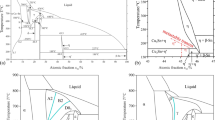Abstract
In Ti-5Al-2Mo-3Zr alloy, TEM observations showed a special feature of “triple twins” in martensite plates after quenching, i.e. three sets of crystals in a martensite plate oriented with the {1¯101} 〈¯1 1 0 2〉 twin relationship between any two of them. This is possible because thec/a ratio of the lattice parameters equals 1.588 in this alloy, and thus the triangle consisting of spots 0 0 0 1, 1 ¯1 0 1 and the central spot in a selected-area diffraction pattern has the interior angles of approximately 30, 60 and 90°. The observations also showed that the boundary between twins II and III was the twin plane {1 ¯1 0 1}, but the boundary between twins I and II was close to {1 ¯1 0 3}, i.e. (1 2 1) of the b.c.c. parent phase. Formation of the triple twins could be explained by the phenomenological theory of crystallography. One pair of twin martensite plates may grow from a pair of twin nuclei which take (1 1 0) and (0 1 1) planes of the parent phase as their respective basal planes. However, the (1 1 0) and (0 1 1) planes are symmetrical with respect to (1 2 1) of the parent phase, which corresponds to a {1 ¯1 0 3} plane of the martensite. The third part of the triple twins forms to meet the need for simple shear according to the phenomenological theory. The formation of triple twins occurs to accommodate the shape change and reduce the elastic energy during the transformation.
Similar content being viewed by others
References
Y. Deng andD. Qiu, in “Titanium Science and Technology”, Proceedings of 6th World Conference on Titanium, Cane, France, 1988, p. 211.
Deng Yongrui, Qiu Dongyao andGao Liang,Rare Metals 8(3) (1989) 27.
N. E. Paton andW. A. Backofen,Trans. Metall. Soc. AIME 245 (1969) 1369.
Idem, Metall. Trans.,1 (1970) 2839.
Z. Nishiyama, M. Oka andH. Nakagawa,Trans. JIM 7 (1966) 168.
Idem, J. JIM 29 (1965) 168.
Idem, Trans. JIM 7 (1966) 174.
C. Hammond andP. M. Kelly,Acta Metall. 17 (1969) 869.
K. M. Knowles andD. A. Smith,ibid. 29 (1981) 1445.
J. K. Mackenzie andJ. S. Bowles,ibid. 5 (1957) 137.
M. S. Wechsler andH. M. Otte,ibid. 9 (1961) 117.
J. S. Bowles andJ. K. Mackenzie,ibid. 2 (1954) 129.
Idem, ibid. 2 (1954) 224.
M. S. Wechsler, D. S. Lieberman andT. A. Read,Trans. Amer. Inst. Min. (Mettal.) Engrs 197 (1953) 1503.
B. A. Bilby, R. Bullough andE. Smith,Proc. Roy. Soc. A231 (1955) 263.
R. Bullough andB. A. Bilby,Proc. Phys. Soc. B 69 (1956) 1276.
Y. Deng, P. Mao andJ. Xu,J. Heat Treat. 8 (1990) 121.
G. B. Olson andM. Cohen,Metall. Trans. 7A (1976) 1897.
Y. Deng, “Martensitic Transformation Theory”, (International Academic Publishers, Beijing, 1991) p. 1.
Author information
Authors and Affiliations
Rights and permissions
About this article
Cite this article
Deng, Y., Qin, Z. Triple twins and martensitic transformation in Ti-5Al-2Mo-3Zr alloy. J Mater Sci 28, 5330–5334 (1993). https://doi.org/10.1007/BF00570085
Received:
Accepted:
Published:
Issue Date:
DOI: https://doi.org/10.1007/BF00570085




